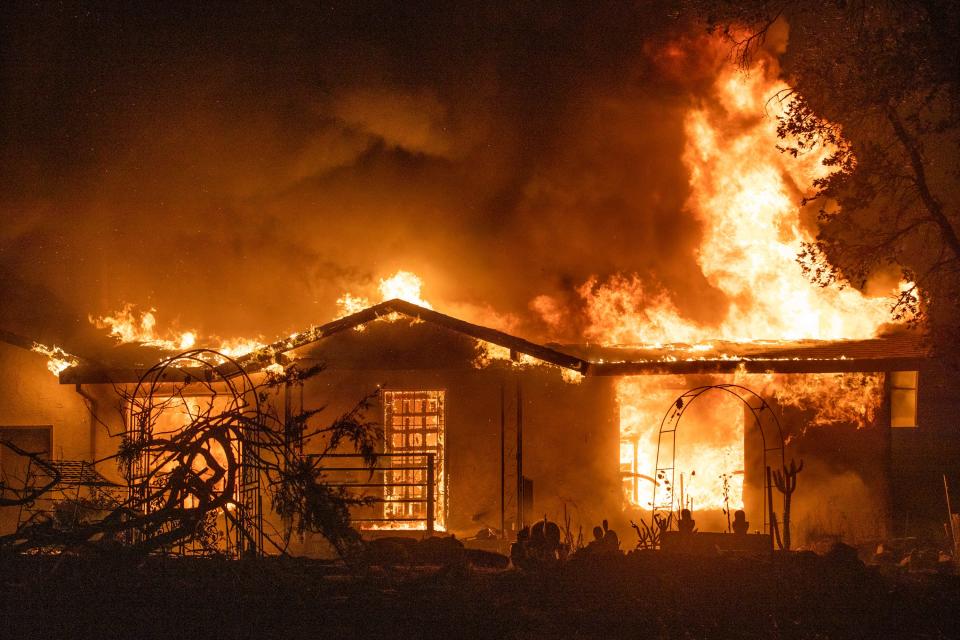Insurance companies are leaving California due to wildfire risk. What homeowners can do.
As homeowners in fire-prone areas face rapidly increasing insurance costs or risk losing coverage altogether, there are things they can do to mitigate the risk of fire damage.
Insured losses on homes and possessions from wildfires in the U.S. have exceeded $13 billion and economic losses have topped $20 billion in three of the past four years, according to Aon. Catastrophe losses related to wildfires at Farmers Insurance Group of Cos. touched $2.1 billion in 2018 alone.
The increased number and severity of wildfires in recent years led to a sharp rise in insurers’ decisions not to renew or write new homeowners insurance policies in California.
State Farm and Allstate insurance companies pulled out of new coverage in the nation’s most populous state, where, according to the Insurance Information Institute, more than 1.2 million homes are at risk for extreme wildfire.
Last year, California Insurance Commissioner Ricardo Lara signed into law a new insurance pricing regulation that would require insurance companies to provide discounts to homeowners and businesses for undertaking wildfire safety and mitigation efforts.
For those efforts to protect homes and reduce premiums, "home mitigation must be comprehensive and not treated as a menu of options," says Seren Taylor, Senior Legislative Advocate, Personal Insurance Federation of California.
Here's how fire mitigation can help protect your property − and possibly reduce your premiums.

What are the best practices for fire mitigation?
A major part of protecting a home from wildfire is paying attention to the defensible space immediately surrounding it, according to the Insurance Institute for Business and Home Safety. The institute recently created the Wildfire Prepared Home designation for homeowners looking to demonstrate the wildfire mitigation actions taken on their property and to qualify for insurance discounts.
Last year, Paradise Town Council in Northern California adopted Wildfire Prepared Home requirements into ordinance, paving the way for a uniform approach to reducing wildfire risk as the town continues to rebuild after the 2018 Camp Fire.
Here are some actions homeowners can take to improve the resilience of vulnerable areas of a home, such as the roof, specific building features and defensible space, including the 0- to 5-foot home ignition zone, according to the institute.
What is the home ignition zone?
The Home Ignition Zone includes the area from the exterior walls to 5 feet out from the building and is one of the most critical aspects of wildfire mitigation. Embers can travel miles and accumulate against your home. Combustible items in this area make your home vulnerable to wildfire ignition.
Remove all vegetation (trees, shrubs, bushes, plants, grass, weeds) including any overhanging limbs or branches from nearby trees or bushes.
Install noncombustible hardscape such as gravel or paving stones around your home and keep it free of debris. Bare soil is also considered noncombustible but may require more maintenance to keep it free from weeds and grass.
Remove combustible items such as wooden and plastic furniture, firewood and trash cans from this zone.
Park boats, RVs, trailers or other vehicles elsewhere.
Learn More: How to prepare for California wildfire season now that insurance is harder to get
What causes deck fires?
A burning deck can ignite siding and break glass in doors and windows, which would allow fire to enter the house quickly. Reducing the deck’s vulnerability requires attention to materials, design features and removing debris monthly.
The institute suggests using nonflammable building materials for the deck, planters and furniture. It also suggests removing combustible pergolas and gazebos as well as any curtains, drapes or screens and using metal pergolas or gazebos instead.
Remove all vegetation (like grass and weeds) that may be underneath and install noncombustible materials such as concrete, gravel or dirt. Create 5 feet of defensible space around the deck or covered porch as part of the 5-foot Home Ignition Zone.
Remove anything stored underneath the deck.
For decks 4 feet or less from the walking surface to the ground, install one-eighth inch or finer metal mesh or fully enclose with a brick, stone or concrete wall around the bottom of the deck to prevent ember intrusion.
Are wood fences a fire hazard?
"Combustible privacy fences made of wood or vinyl can ignite and act like a wick leading fire straight to your home," the institute warns.
To help prevent this, fencing attached to your home or within 5 feet of your home should be made from a noncombustible material such as metal.
Also, remove any back-to-back fencing. This may require you to coordinate with your neighbor(s) to eliminate duplicative fences that can trap debris between them.
EXCLUSIVE Homes with high wildfire risk are selling for $178,000 more than low-risk homes
How can we reduce the risk of wildfires outside the home ignition zone?
Wind-blown embers can still ignite plants beyond the zone, making plant selection and maintenance critical to reduce flame intensity near a home.
So, it's important to:
Routinely remove fallen pine needles, leaves, other debris from trees in the yard.
Remove groups of trees and prune remaining ones to have a canopy-to-canopy distance of at least 10 feet (distance should increase with slope). Also, prune branches to at least 6 feet off the ground.
Space out shrubs or bushes to avoid rows of bushes that can lead to fire spread.
Routinely remove dead vegetation.
This article originally appeared on USA TODAY: What homeowners can do to reduce wildfire risk and keep insurance
